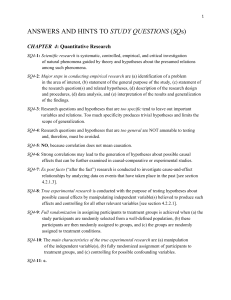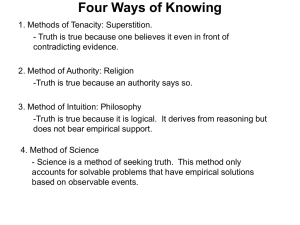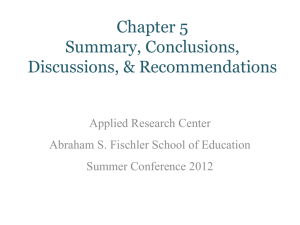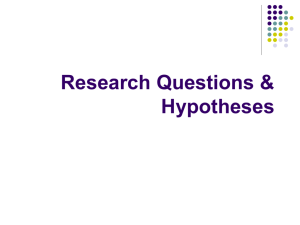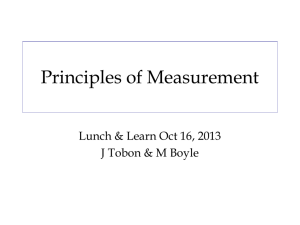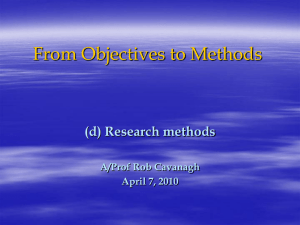Intro to Experimental PSYC
advertisement
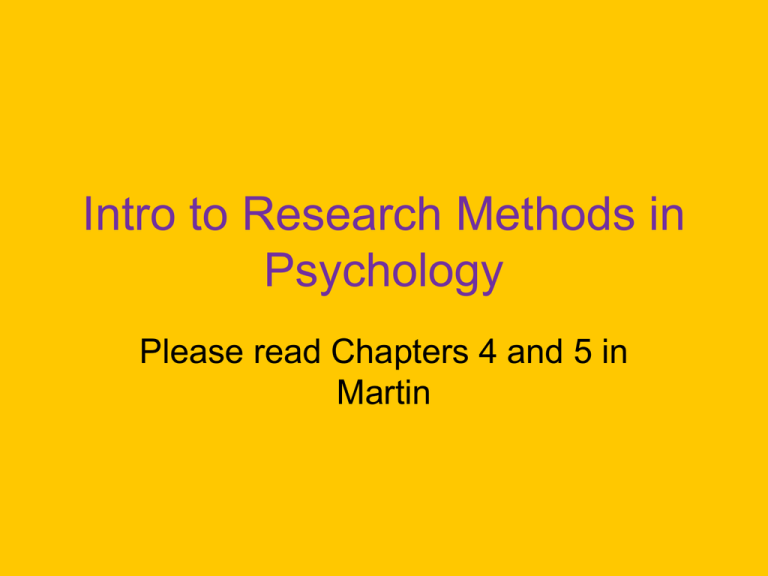
Intro to Research Methods in Psychology Please read Chapters 4 and 5 in Martin Major Topics • Research -- what it is. • Planning a research project. • Selecting the research units (“subjects”) from which data will be collected. • Constructing or obtaining the instruments used to collect data. • Relative merits of commonly employed research designs. • Analysis of the data. • Preparing a research report. Social Sciences Research Research in the social sciences (including psychology) is – theoretical (sometimes), – empirical – nomothetic, and – probabilistic A Scientific Theory • A model of how basic constructs and measured variables are related to one another. • Constructed by induction – inferring the general from the specific. • Generates predictions (hypotheses) by deduction – inferring the specific from the general. • • • • Tested by attempting to falsify. From theory, derive hypotheses. Gather relevant data. If data match hypotheses, theory supported. • If not, modify theory or abandon it. • Is not just a hunch. • Explains all known facts in domain of interest. • Must be refutable. Exploratory Research • Not all psyc research is theory-driven. • I can wonder about the relationship between X and Y without any guiding theory. • Exploratory research provides the raw materials from which theories are refined. Empiricism • Epistemology – origins and nature of human knowledge • Rationalism – knowledge through thought – Pythagoreans, Socrates • Empiricism – knowledge through sensory experience Nomothetic • Applies to the general case. – We study individuals – to explain, predict, and control behavior – not just in one individual, but in most. • As opposed to idiographic. – where the focus is on a single individual. Probabilistic • Our interest is in the entire population – for example, correlates of perceived attractiveness in all humans. • But our data (sample) represents only a small proportion of that population. • So our conclusions cannot be free of possible error – must be stated in probabilistic terms. Three Basic Types of Research • Descriptive (Univariate) • Relational • Causal Descriptive Research • Univariate – work with only one variable at a time. • Example: How many people dream in color? Relational Research • Determine how variables are related to one another. • Is age related to dreaming in color? • Is sex/gender related to dreaming in color? • Is arousal of certain brain areas related to dreaming in color? Causal Research • Is X a cause of Y? – If I manipulate X, will Y change? • Establish that X and Y are related. • Rule out (noncausal) alternative explanations. • Employ experimental methodology. • Eliminate confounds. Third Variable Problems Research and Time • Cross Sectional Research – Compare political attitudes of 20 vs 50 years olds. – Differences due to maturation or ?? • Longitudinal Research – Follow multiple cohorts, measure at 20, 30, 40, 50 years of age. • Repeated Measures and Time Series Patterns of Relationships Between Continuous Variables • • • • • None Positive Linear Negative Linear Curvilinear See Bivariate Linear Correlation. Hypotheses • • • • • • Null hypotheses Alternative hypotheses Nondirectional hypotheses Directional hypotheses Sharp/Point null hypotheses Loose/Range null hypotheses A Research Project From Start to Finish Formulating the Initial Broad Question • Experiencing a practical problem. • Familiarity with past research and theory. • RFP – requests for research proposals. • Curiosity about everyday experiences. – my curiosity regarding attitudes about animal research Narrow Down the Question • Want a question that can be well addressed in a single research study. • Focus in on one or a few parameters – Theory may suggest which parameters are most important – Or you just might have a hunch while sitting on the couch watching the news. – How is misanthropy related to attitude about animals? The Research Hypothesis • Theory, insight, or hunch may suggest an answer to the question posed. • This becomes the research hypothesis. • Ethical cost/benefit analysis and a relationship between misanthropy and attitudes about animals. Operationalization • How to manipulate or measure the concepts in the research hypothesis. • Manipulate misanthropy by exposing some subjects to depictions of evil humans. • Develop questionnaire to measure misanthropy. Reviewing the Literature • Has somebody else already answered this question? • If so, what additional research is suggested by those results? • Have others addressed similar questions? • How did others operationalize constructs, recruit subjects, get grants, analyze the data, and so on. Procedural Details and Feasibility • • • • • • Prepare a step-by-step plan. Can you afford it? If not, are there less expensive methods? How many subjects will you need? How can you motivate your subjects? From whom will you need permission, cooperation, or assistance? • Are there statistical procedures available to analyze the data you will collect in a way that will answer your question? • Can you conduct such analysis yourself or will you have to hire a research statistician? Gathering & Analyzing the Data • Consider conducting a pilot study. • You can count on some things going wrong. Be prepared to deal with them. • Screen your data to determine if you can analyze them the way you intended to. If not, adopt alternative analysis. • Be on the lookout for unanticipated findings and be prepared to shift your attention to them. Using Your Statistical Results to Answer Your Question • If your question was simple, your design experimental, and your results what you expected, this is a breeze. • Otherwise, be ready to sweat it out. Writing a Research Report • Share your results with the world. • Use the style appropriate for your discipline. • For most psychologists, that is the style of the American Psychological Association. • I have (or will have) taught you the basics of APA style. Research Validity • • • • Will your research lead to conclusions that fit the available data and stand up to criticism. Statistical Conclusion Validity Internal Validity Construct Validity External Validity Statistical Conclusion Validity Determine the extent to which variables are related. • Power • Efficiency of Estimation • Robustness Internal Validity Is there a causal relationship between these variables? • Experimental research • Various threats to internal validity Construct Validity Have we operationalized our constructs well? • We have demonstrated a relationship between our measured variables. • Does this make us confident that there is a relationship between the underlying constructs? External Validity Can we generalize the results? • to other types of subjects • to other situations • to other measurements of the constructs • etc.
